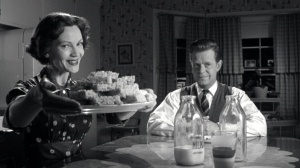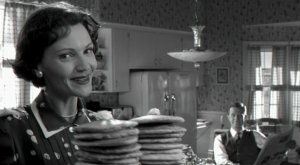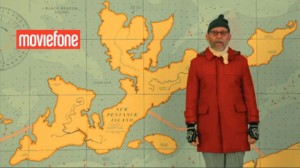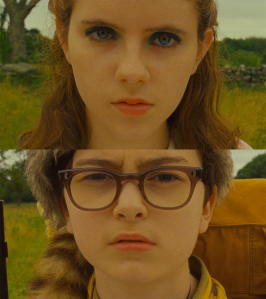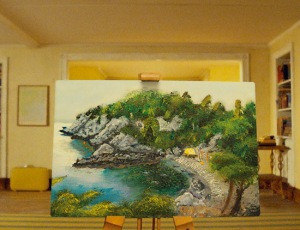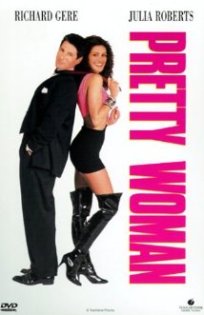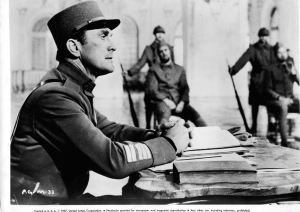Following what Frederic Jameson suggested, it can be argued that the contemporary consumer society is a culture mainly characterised by being postmodern. But the way Jameson defines postmodernism is much more than just being something that succeeds modernism, but a movement that rises from its very opposition. According to Belton (1994), although modernist work had once been considered to be revolutionary, because its canonization, “artists were forced to revolt (against it) in an attempt to say something new and different” (307). As a way of rebelling against modernism, postmodernism ignores all traditional distinctions between high and low culture. From a stylistic point of view, further following Jameson’s account (as referenced in Storey 2005), it represents a culture of pastiche, mutilated by the “complacent play of historical allusion” (135). It is seen as a world where there is no space left for any kind of stylistic innovation, as there is no longer the ability to “say anything that has not already been said” or “to create or to express that which is unique or novel” (Belton 1994: 308). Creativity is seen to have been replaced by a “culture of quotations” (Storey 2005: 135), where cultural productions created out of other cultural productions have replaced pure creativity.
Jameson further describes postmodernism as a culture of unrefined superficiality, characterised by images and surfaces that have no depth and only derive from other images and surfaces. Although he does acknowledge the fact that modernism itself ‘cited’ from other cultures, he insists that there is an elementary difference between the two: “postmodern cultural texts do not just quote other cultures, other historical moments, they randomly cannibalize them to the point where any sense of critical or historical distance ceases to exist- there is only pastiche” (136). This particular feature of postmodernism arises from the fact that the authentic ideas that have been expressed in the past have now been replaced by indirect references and hints to those unique representations (Belton 1994).
Jameson links this incapacity of being original with another feature of postmodernism, which is nostalgia for the past. What he calls ‘nostalgia film’ is probably one of his most well-known examples of postmodern culture of pastiche. He defines this type of film as trying to “recapture the atmosphere and stylistic peculiarities of America in the 1950s” (Storey 2005: 136). However, he explicitly insists on making a distinction between nostalgia films and historical ones, as the first ones do not attempt to recapture the true ‘reality’ of the past, but only certain stereotypes and myths about what characterised it. This is what Jameson calls ‘false realism’, a “random cannibalization of the past” (Storey 2005: 136).
Intertextuality is another feature of postmodern films mentioned by Storey (2005) which, in his opinion, cannot be simply understood as pastiche or recycle of nostalgia. He argues that intertextuality should be seen as borrowing something that already exists in order to make new combinations of what is old. Old is therefore “not simply replaced by new, but is recycled for circulation together with the new” (Storey 2005: 139).
Lastly, postmodernism is seen by Jameson as a schizophrenic ordeal, as he believes that people can’t handle past, present and future only as linear, which is why they can only live in a series of perpetual present. This leads to an increasing fragmentation of the self and, according to Belton (1994), as a results of this layered self, postmodern artists only manage to convey “the incoherence of their internal reality” (308-309).
It is in relation to these elements (and not only) that this essay will try to analyse Pleasantville as a postmodern text. Although the arguments will mostly be developed around aspects of Jameson’s critique, they won’t necessarily be approving or disapproving of his argumentation.
The films begins with a series of short clips taken from news and statistics presented in various classrooms about unemployment, AIDS and famine predicted to happen in the close future, which are all depictions of the current society’s distress. David (Tobey Macguire), “a devotee of cable reruns, (…) is an arch consumer of 1990s nostalgic camp” (Grainge 2003: 204). Part of a dysfunctional family (which can be deducted from his mother’s phone conversation), he seems to be looking for some sort of refuge. He finds his hide-away in watching ‘Pleasantville’, the 1950s sitcom, as by doing that he can drown out the problems of his own life. Nostalgia is therefore set up at very beginning, in the opening sequence.
The channel hopping, the multitude of voices and noises, the quick pace, the colours and the flashing lights are all in opposition with the black and white and the slow pace of the show.
Just like emphasized by Grainge’s analysis (2003), colour is a central element in how Pleasantville structures its narrative. As such, black and white is a “visual index of the (…) caricatured morality of the 1950s” (205), the monochromatic aspect of it being a depiction of that society’s codes and conventions: sex and sexuality as taboos, the conservativeness of fashion, family values at the core of everything, the lack of concern with body image and eating patterns etc.
Mary Sue: “Are you sure I’m supposed to wear this? I could like kill a guy with these things.” (Jennifer, as Mary Sue, while getting ready to go out with Skip Martin, the basketball team’s captain)
Bud: “He won’t notice anyway.”
Mary Sue: “Why not?”
Bud: “Well, they just don’t notice that kind of thing around here.”
“Pleasantville is (thus) a place without double beds, working toilets or domestic arguments” (205), a place where everyone has the security of their own home.
“Nobody’s homeless in ‘Pleasantville’ because that’s just how it’s like
(David, while watching his mom put her suitcases in the booth of her car and drive away).
The ideal nature of life presented in the sitcom is further emphasized by the scene when David (who had just become Bud Parker) realises he can actually play basketball, as he manages to score from every single position. Even though parody becomes more apparent as the film unfolds (as it will be further discussed), it is lying underneath all scenes, highlighting the artificial construction of the so-called perfect society.
If colour is at first associated with realism and is used to frame David and Jennifer in the reality of the 1990s, it starts to gain dramatic meaning as time gradually unfolds itself in Pleasantville. As previously mentioned, monochrome was associated with the values and conventions of the idealised 1950s society. However, as soon as the two intrude and disrupt the normal unravel of events, colour begins to appear. The moment Jennifer and David introduce the people of Pleasantville to pre-marital sex, rock ‘n’ roll music, modernist art, literature and a very different way of acting in the society, their entire life changes and it can thus be argued that richer and more intense colours are in this case synonym to the awakening of the community. The use of black and white and colour stops therefore being just a way of demarcating past and present, but is instead “used as form of spectacular excess in a black and white past that is itself fantastical” (Grainge 2003: 205).
The spectacle of colour doesn’t bring all the changes without the protest of the people resilient to changes to their “norms of domesticity, fidelity, property and pleasantness” (206). In the end, however, the protest is suppressed and changes are embraced.
There are many elements discussed at the beginning of this essay that can be found throughout the film, two of them being pastiche and parody. As previously mentioned, the concept of pastiche refers to the ‘random cannibalization’ of elements of the past, without questioning them in any way, while parody additionally requires critique (which involves a deeper level of analysis). It can be thus argued that Pleasantville starts out as a pastiche (the codes and conventions of the 1950s presented at the beginning don’t provide a penetrating insight), but turns into parody as the film goes on. However, it can also be argued that because it doesn’t address or explore any of the society’s problems mentioned at the very beginning (unemployment, AIDS, famine), Pleasantville represents a superficial postmodern cultural text which depicts “superficiality in the most literal sense” (Storey 2005: 136).
Another element is nostalgia, which is apparent since the very first scene, when David, in an attempt to escape the reality of his own life, refuges himself in the 1950s sitcom. He seems to be running away from the aspects of the contemporary world. This might be because of his dissatisfaction with where he is at the moment and the pressures of his current life or maybe because of all the rejections he seems to be facing. He might also be against the advanced consumer society, which is why he might be longing for a more simple way of life, regulated by a structure at the foundation of which there are reasons and motivations. The 1950s society presented in the Pleasantville sitcom is a world of plastic harmony and dependability which strongly contrasts David’s messy life. Interesting to notice, although the feelings of nostalgia and longing for that better time are very prevalent at the beginning, the perspective seems to change and the values of the 1950s society that David is nostalgic about start to somehow be critiqued. A relevant example is the scene with David and Bill, when the latter expresses his dissatisfaction with the monotonous unfolding of his life:
David: “You make hamburgers, that is the point!”
Bill: “I know I do. It’s always the same, you know? Grill the bun, flip the meat, grill the cheese…it never changes! It never gets any better or worse.”
This particular scene can therefore be seen as a critique of the dullness, routine and lack of diversity that characterised the society of that time.
Truly worth of postmodern definitions is yet another shift in perspective, illustrated by the scene where, after being introduced to the world of sex, Skip Martin goes to pick up Mary Sue. In a totally uncharacteristic manner though, she refuses his invitation, arguing she is busy studying. This particular scene marks a turnover in what the film criticises, as it now seems to be women’s sexuality that is being rejected.The explanation for this change might be the self-discovery journey that David and Jennifer are embarking to, while themselves changing the lives of other people. During the time David and the people from Pleasantville are learning their lessons from the modern life, Jennifer discovers the world of books and the importance of education in the process of women’s emancipation (there are many instances that contribute to her desire to change something in the way women are being treated and the rights and freedoms that they’ve got). All these elements seem to fit Jenck’s definition of postmodernism, who defines it as an eclectic mix of any tradition with that of its immediate past.
The ‘Burning Bush’ scene can also be seen as a conservative way of suggesting that female sexuality is destructive. Masturbation is therefore seen as a sin, as the fire that breaks out in the tree is symbolic of hell. However, this scene can also be interpreted as a postmodern preoccupation with showing the taboos of women.
A further reference to women’s rights, freedoms and their place in the society is the scene when George comes home only to find that Betty is gone. However, his shock doesn’t come from realising he had been left by his wife, but from the fact she hadn’t made him any dinner.
The end of the film is an ambiguous one, as it suggests that although it is normal to be resilient to it, change represents something good and it is okay to accept it even if not knowing what it might bring.
David: “Nothing went wrong, people change.”
Bill: “People change?”
D: “Yes, people change.”
B: “Can they change back?”
D: “I don’t know, I think it’s harder.”
(…)
B: “It’s not fair, you know? You get used to one thing and then…”
With regards to intertextuality, which is believed to take place of historical texts, Pleasantville contains a lot of cultural references. According to Aichele and Walsh (2002), “it is common in fantastical narratives for a magical gate or passageway to connect the realistic world to the fantasy one” (103). There are thus many familiar examples that Pleasantville makes references to, including Alice in Wonderland, Peter Pan and The Wizard of Oz. Furthermore, it is not only the existence of the connecting gate between the two worlds that is common, but also the employment of both black and white and colours. From this point of view, Pleasantville can be compared to The Wizard of Oz, where colour represented the magic world of Oz, whereas the dull reality of Kansas was illustrated in black and white.
Further examples of intertextuality include all the artworks featured in the film, such as: Masaccio’s ‘Expulsion from the Garden of Eden’, Titian’s ‘Venus of Urbino’, Turner’s ‘Rain, Steam and Speed’, Picasso’s ‘Weeping Woman’.
Another postmodern element that Jameson would have criticised is the way the 1950s society was portrayed in the sitcom, as it seems to be the perfect example of what Jameson calls ‘false realism’. It can be argued that the sitcom presents a flattened history, only emphasizing some of its parts and only constituting a representation of that time and not that time itself. It is just a simulation, an aesthetic nostalgia of the 1950s. The flattening of history is illustrated by the mix of rock ‘n’ roll and jazz that are presented simultaneously. A further example of this lack of depth is the fact that neither the film nor the sitcom has black or gay characters, which is thus far from being an authentic depiction of society.
Whether it’s nostalgia, intertextuality, pastiche or parody, Pleasantville represents the embodiment of many characteristic features of postmodernism. And even though it contains a wide mix of elements that can be argued to simply be part of a superficial collage, the film does go a bit deeper than most postmodern texts, managing to creatively blend two opposite worlds (a monochrome and a coloured one), while speaking volumes about values, prejudice and diversity.
REFERENCES:
AICHELE, G. & WALSK, R. 2002. Screening Scropture: Intertextual Connection Between Scripture and Film. Philadephia: Trinity Press International.
BELTON, J. 1994. American Cinema/American Culture. USA: Belter Graphics, Inc.
IMDb. 1998. Pleasantville. [online]. IMDb. Available from: http://www.imdb.com/title/tt0120789/ [Accessed 17 April 2013].
JAMESON, F. 1991. Postmodernism: Or, the Cultural Logic of Late Capitalism. USA: Duke University Press.
STOREY, J. 2005. Postmodernism and Popular Culture. In: SIM, S. (ed.) The Routledge Companion to Postmodernism. 2nd edition. London: Routledge.

